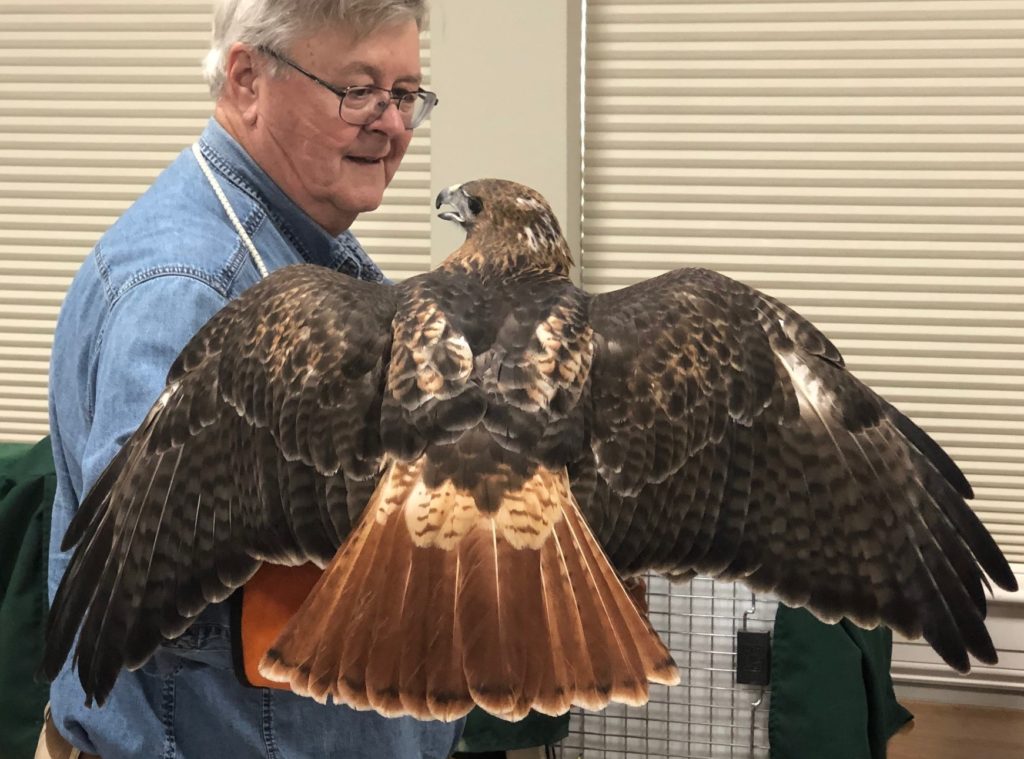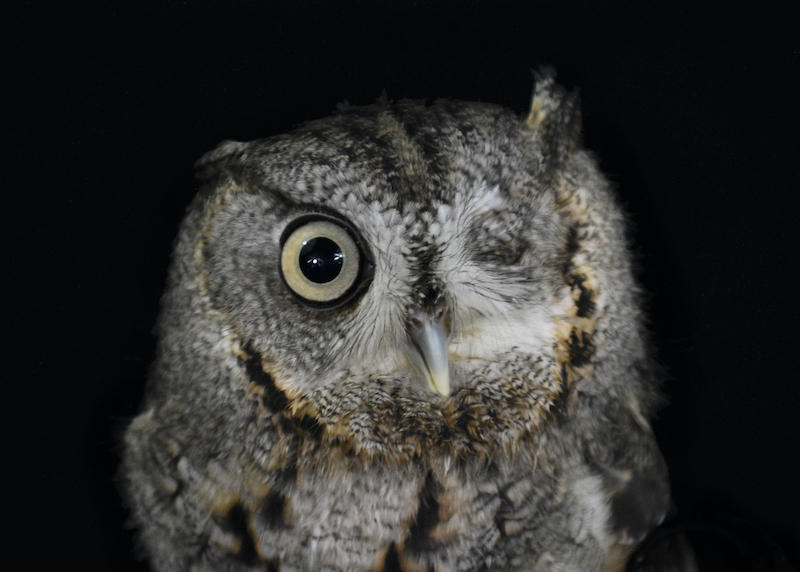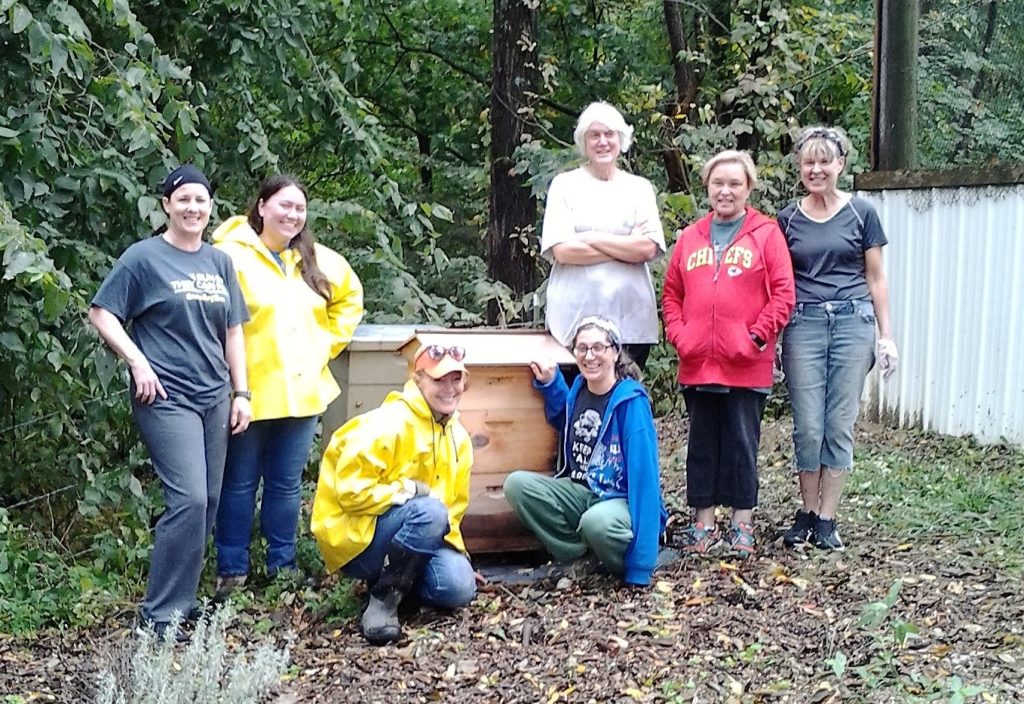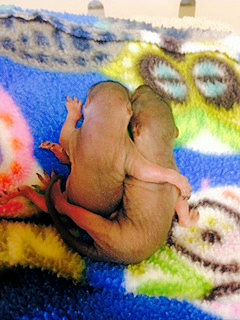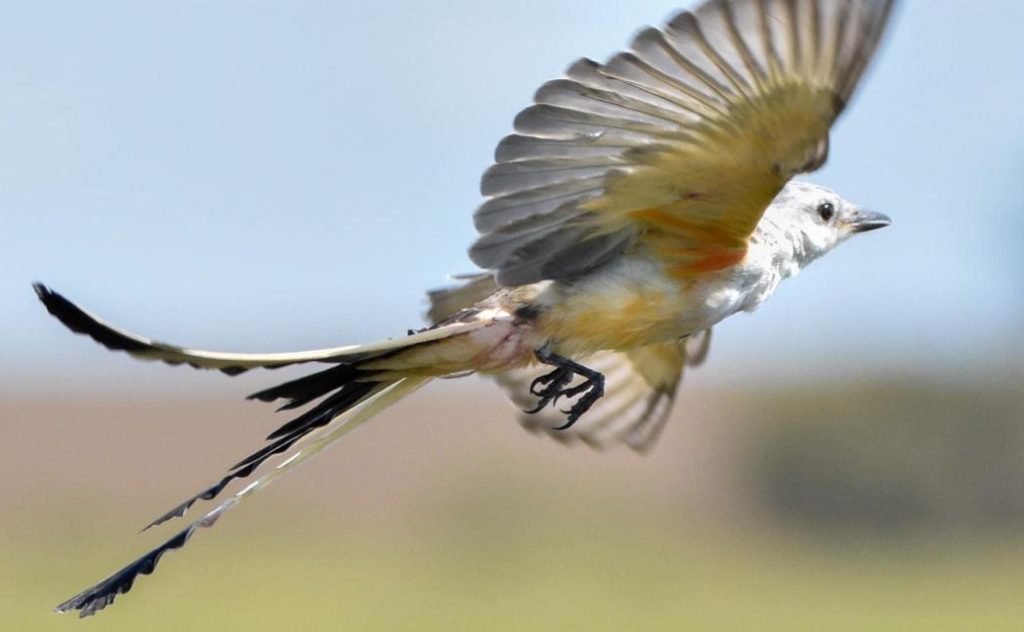About
Bats
Bats are the only flying mammals (flying squirrels glide). Most bats in the North America are insectivores, and one bat can eat between 2,000 and 6,000 insects each night. Insects they eat include agricultural crop pests, including the tomato horned worm, corn earworm, and many kinds of beetles. Bats also eat insects, flies, mosquitoes, and gnats.
Most bats live between 10 to 20 years. Some bats live 30 years. When winter comes, some bats migrate to warmer climates, but most in our area hibernate in attics, caves, or the hollows of trees. Hibernation allows them to avoid freezing temperatures and starvation since the insects they consume are not available in the winter. During hibernation, a bat’s heart beats only about 11 beats per minute.
In contrast, when bats are awake and flying, their heart pumps over 1,000 beats per minute.
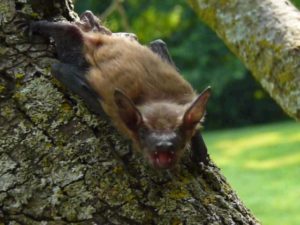
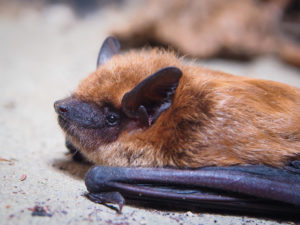
Most Common Species in Northeast Kansas
- Little Brown Myotis
- Brown Bat
- Red Bat
- Hoary Bat
Bats are the only flying mammals (flying squirrels glide). Most bats in North America are insectivorous. In Kansas, we have two types of bats: crevice dwelling and tree roosting. Crevice dwelling bats are normally brown and tree roosting bats are red or silver.
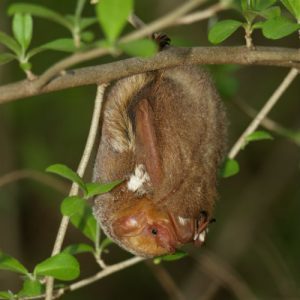

Bats – To rescue or not to rescue
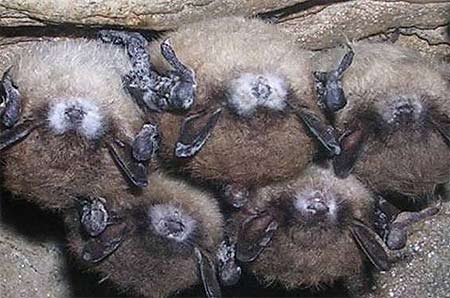
Bats found indoors
A bat found indoors is most likely a crevice-dwelling species (i.e. in Kansas—big brown bat, little brown bat). Although the fur color of crevice-dwelling bats varies, it is usually dark brown, and they do not have fur on their tail webs. These bats are often lost youngsters, passing migrants, or temporarily aroused hibernating bats. Bats found indoors during the winter, early spring, or autumn may have come out of torpor in response to higher-set thermostats and are more likely to be dehydrated and malnourished.
A flying bat is almost impossible to catch, and you have a greater chance of injuring yourself and the bat if you attempt to capture it while it is airborne. In addition, bats that are caught while flying frequently panic and attempt to bite. Be patient.
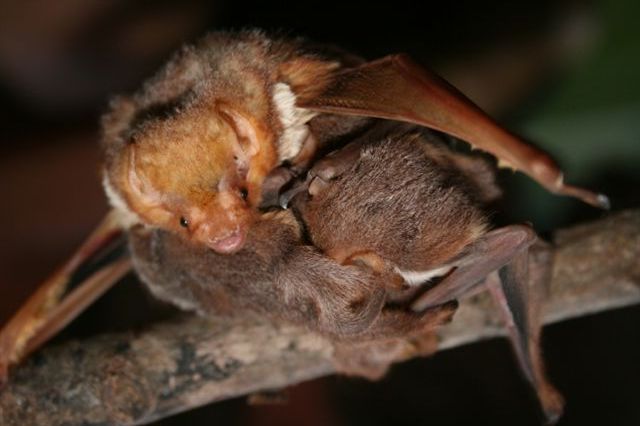
Bats found outdoors
Bats are frequently found on the ground in early summer when mothers are moving their young or when they become grounded following bird attacks or storms. Crevice-dwelling bats found grounded may be sick and will need to be examined and cared for by OWL. Mother bats carry their young with them and in hot weather will often get dehydrated, exhausted, or overheated, causing them to be grounded. Bats under the eaves of a house, behind a shutter, or hanging in a tree are best left alone in the daytime roost—most likely, it will be gone by morning. Bats found on the ground, especially on a hot, sunny day, or clinging below five feet and exposed to predation or the elements should be brought in for care.
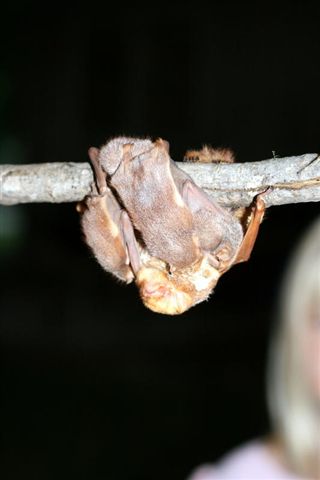
Steps to follow if you find a bat
- Wait until the animal is motionless. Occasionally, bats panic and defend themselves when humans approach by spreading their wings in mock attack and making loud hissing or clicking.
- Contain the bat. See instructions below. Note: Do not place the bat in a birdcage or container with small openings. Bats are very intelligent and can easily squeeze through a 1/4-inch crack.
- Contact OWL.
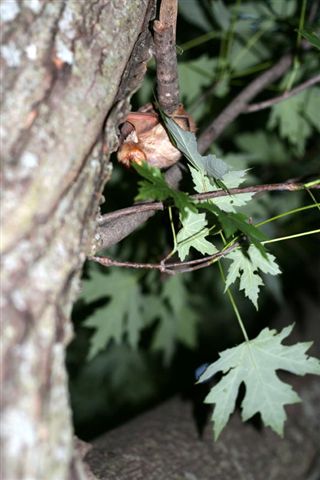
Maternity periods and baby bats
Bats often roost in buildings during maternity periods where they give birth and raise their pups. Exclusions should not take place until young bats can fly; otherwise, they will be trapped, away from their mothers and die of starvation. Separating pups from the mothers may lead bats to search for other entrances to reach their young. The maternity season begins as early as mid-April in Kansas. Young bats are flying by late August. Exclusions should not be conducted between April and late August.
Signs of Injury
If you notice any of these issues, contact OWL as soon as possible:
- Cold and lethargic.
- Covered with fleas, ants, ticks, or flies/fly strike (looks like small clusters of rice anywhere on the animal).
- Dehydrated.
- Has been fed any kind of formula or food.
- Has been in a cat’s or dog’s mouth.
- Broken limb, cuts, or bruises.
- Head tilt.
- Bleeding.
- Unable to stand or move without falling over.
Common Concerns
You can exclude bats from living quarters by covering chimneys and vents with quarter-inch hardware cloth screens, by installing draft guards beneath doors, and by sealing any other access routes, especially around screen doors, windows, and plumbing. You can plug entries with silicone caulking, steel wool, or temporarily with tape.
If a large bat colony must be evicted from a wall or attic, you should make careful observations at dusk to find entry holes. The bats must emerge each summer evening to feed. Once entrances have been located, you can exclude the bats, although this should not be attempted when flightless young may be present that can be trapped with no exit. (Usually April through August.)
You can use this simple exclusion technique after the young are flying, but prior to the winter months.
Inexpensive lightweight polypropylene netting with mesh size of a quarter inch or smaller (1/6 inch is preferred) can be purchased in a quantity large enough to cover areas of nearly any size. You can hang it during daylight hours over areas where bats emerge using duct tape or staples.
Cut a strip of this netting long enough to extend two feet below the bat exit hole and wide enough to extend two feet on either side of the exit hole. Attach one to two inches above the exit point with the tape or staples. This will allow the bats to emerge from the wall or attic but prevent them from being able to re-enter. A sheet of heavyweight, clear plastic will have the same effect. The netting (or plastic) should be left in place for two to three days to ensure all the bats have left the roost. The netting acts as a simple one-way excluder and should be left in place until repairs can make the exclusion permanent.
Most crevice-dwelling bats migrate to warmer climates, seek attics, caves, or other hollow areas to hibernate in the late fall. If hibernating bats are present in cold regions during the winter, you should postpone exclusions until spring when they emerge to feed. In mild climates, some bats may remain active year-round, but exclusions should be carefully monitored or avoided during periods when night temperatures fall below 50 degrees F (10 degrees C).
- Have you or anyone else had PHYSICAL contact with the bat?
- Has the bat bitten, scratched, or had any contact with bare skin?
- Was the bat found in a room/house where it might have had contact with someone who may not be aware? (Sleeping person, young children, disabled person, or someone intoxicated)
- Have your pets been in the home/dwelling with the bat and unsupervised?
- Bat’s teeth are extremely tiny. It IS possible to be bitten by a bat and not have a mark. Think of a tiny diabetic syringe needle. If something that tiny in stuck your 5-year-old their sleep, it is possible that you would not find a mark on her and they wouldn’t have awakened when she was bit.
If you answered YES to any of the above questions
- Attempt to capture the bat if possible. * (Close the door to the room where you found the bat. Keep windows closed.)
- Wash the bite wound with soap and water.
- Contact your physician or the local emergency room as soon as possible for instructions.
- If you can capture the bat, call local animal control department so they can test the bat for rabies.
*Sometimes, you can avoid rabies shots by having the bat tested. When the animal is captured, it can be lab tested at K-State. If it tests NEGATIVE for rabies, you will not have to complete the post-exposure rabies protocol/treatment. When there is human exposure, the lab can normally have results in 24 hours.
In 2011, we started receiving calls about a new disease that seemed to be affecting our bat populations in the Midwestern states (including Kansas. This new disease is called White Nose Syndrome (WNS). WNS is a disease caused by a fungus, Geomyces destructans, that attacks cave-hibernating bats. First discovered in New York state in 2006, it has rapidly spread throughout the northeastern states, the Appalachians, and into Canada. Since 2007, it has killed at least one million bats of six species. All species of bats found in Kansas are known to be susceptible. WNS has only been found to infect bats; humans and other animals are not known to be affected.
For more information on bats please contact:
BAT CONSERVATION INTERNATIONAL
500 N Capital of Texas HWY, Bldg 1
Austin, TX 78746
(512) 327-9721
(800) 538-BATS
How to Transport a Bat
If you need to bring an animal into OWL, the most important thing you must do is to keep them warm and quiet.
Step 1
Wait until the animal is motionless.
Step 2
Contain the bat. The easiest way to do this is to approach the bat quietly and dangle a towel/blanket/cloth in front of the bat’s face. Wear thick leather gloves. The bat should grab onto the cloth, allowing you to slowly move the cloth into a plastic bag, cardboard box, or container with a lid. If the bat will grab onto the fabric, you will not have to touch him at all. If he will not grab on, wearing your gloves or using a very thick towel, gather the bat (gripping it securely but not tightly) and place it into a box or container with a lid.
Step 2: Alternative
Another method is to simply place a box, waste can, coffee can, or similar object over the bat where it has landed. Then, take a piece of cardboard and gently slide it between the box and the surface the bat is on (i.e. floor, wall or ceiling). Keep the cardboard in place and gently turn the container right side up.
Note: Do not place the bat in a birdcage or container with small openings. Bats are very intelligent and can easily squeeze through a 1/4-inch crack.
Step 3
Take the container with the bat outdoors to release. Place the bat a minimum of four to five feet up on the side of a tree. Bats need “swoop-down” room to fly. Bats CANNOT lift fly out of a grounded container in a vertical position.
Step 4
Conditions when a bat needs to be brought to OWL:
- Below 50 degrees outside or during inclement weather.
- Orphaned baby bat, sick, injured, or unable to fly: place the bat in a secure container with small, less than 1/4-inch, air holes, and provide a soft cloth (not terrycloth), hanging on the inside of one of the vertical sides of the container so the bat can hang upside down and feel safe by hiding in the folds.
- If the bat does not fly away, or attempts to fly but seems unable to, it is likely that is has an injury or illness. It may also be a disoriented juvenile, dehydrated, or starved from being trapped indoors.
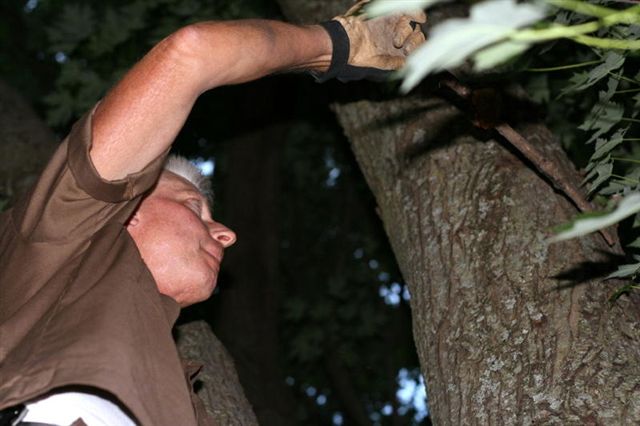
Bats & rabies
Over the last 50 years, fewer than 40 people have contracted rabies from bats.
Scientific studies have shown that fewer than one percent of wild bats test positive for rabies. Nationwide, about five percent of bats sent to state laboratories test positive for rabies. This number is higher because sick individuals are more likely to be caught and turned in for testing. Most colonies from buildings contain no rabid individuals. If you encounter a bat, contact your family physician or health department for advice regarding testing and treatment. Pets should be vaccinated against rabies to ensure their safety from wild mammals.
important things to know
- Sick bats do not seek people out for attack; they generally search for a secluded spot to die quietly.
- According to the Center for Disease Control, you cannot get rabies contact with bat guano (feces), blood, or urine or from touching a bat on its fur (even though bats should never be handled).
- If you are bitten by a bat, or if saliva from a bat gets into your eyes, nose or mouth, seek medical attention immediately. Whenever possible, the bat should be captured, and local health department notified. If a pet was bitten, contact your veterinarian for advice.
- Pets should always be current on rabies vaccinations to protect them from encounters with bats or any other wild animal.
- If a bat or bats are found in a room with a person who cannot reliably rule out physical contact (for example: a sleeping person, a child, a mentally disabled person or intoxicated person), those bats should be tested for rabies.
- If you had contact with a bat and were advised to get rabies vaccinations by your physician, the series of shots are administered over a period and given in the upper arm. You will NOT have to get 50+ shots in your stomach, or any other wild stories that people like to talk about. Many of our wildlife specialists have had rabies shots in the past.
- Please know that rabies is readily prevented by the post-exposure shots but is 99% fatal after symptoms appear.
- Do NOT put off reporting a bite! . . . . Call your health department, animal control department, and physician. If you are having trouble getting information you need, call us, and we will direct you to the right people.
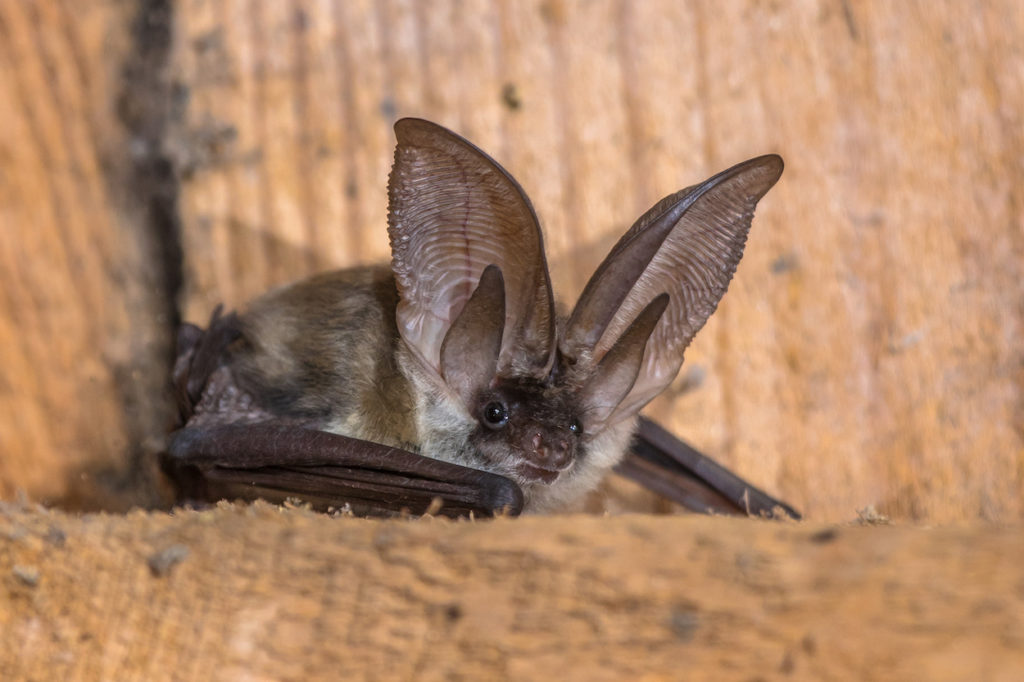
Contact Operation WildLife for help.



